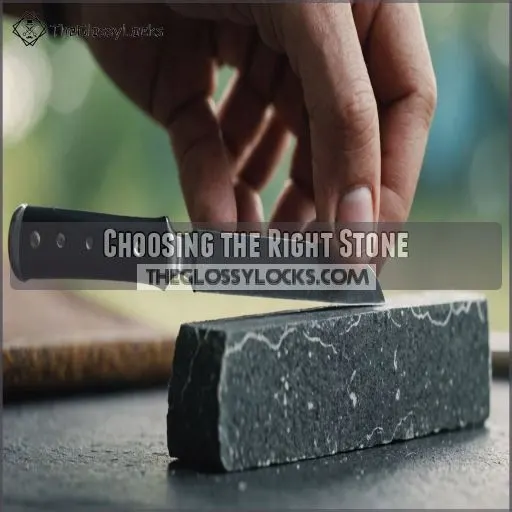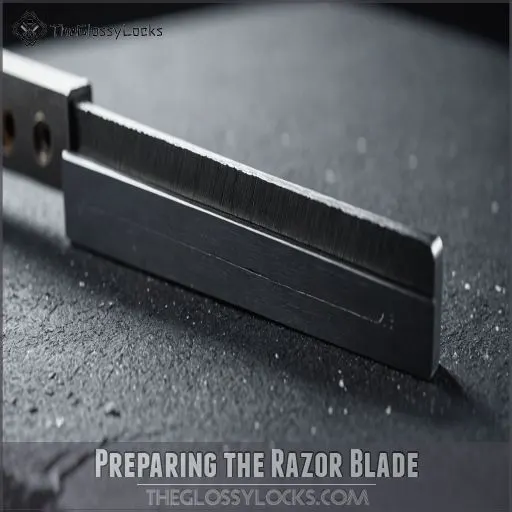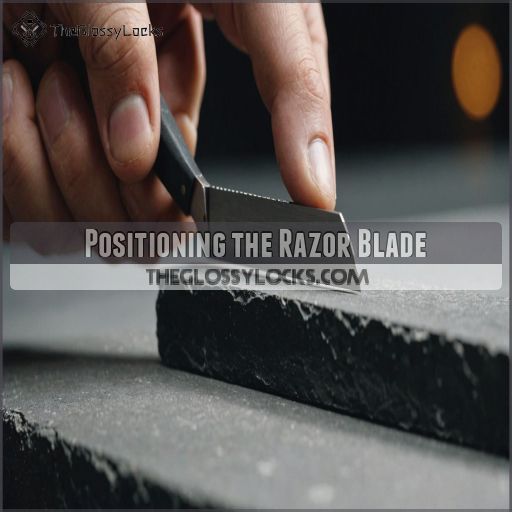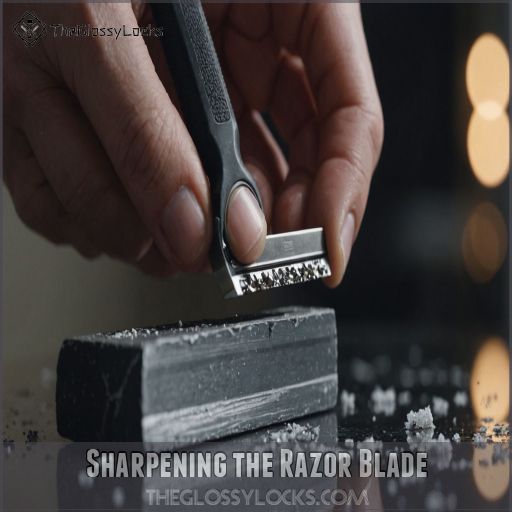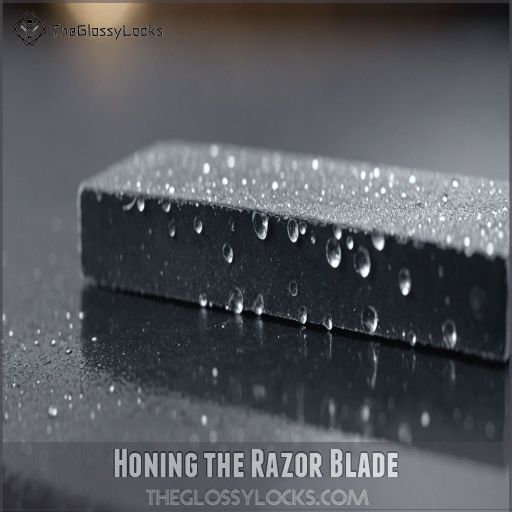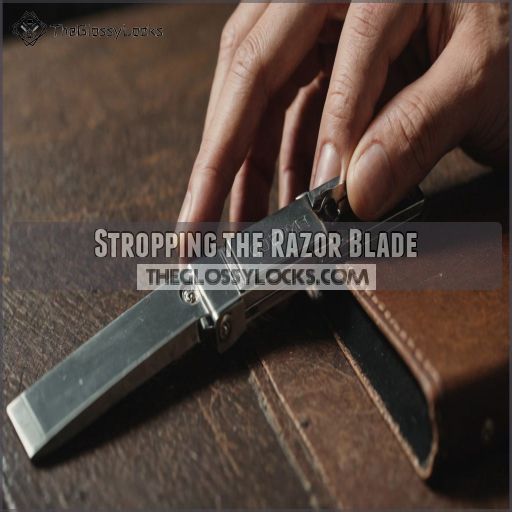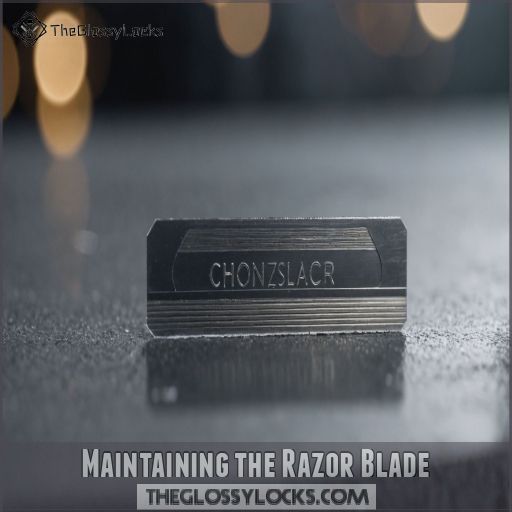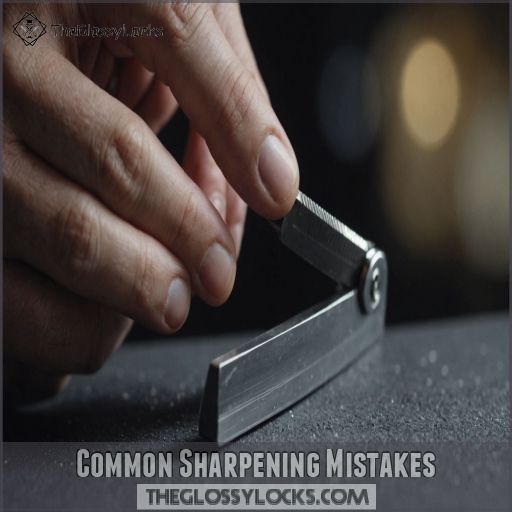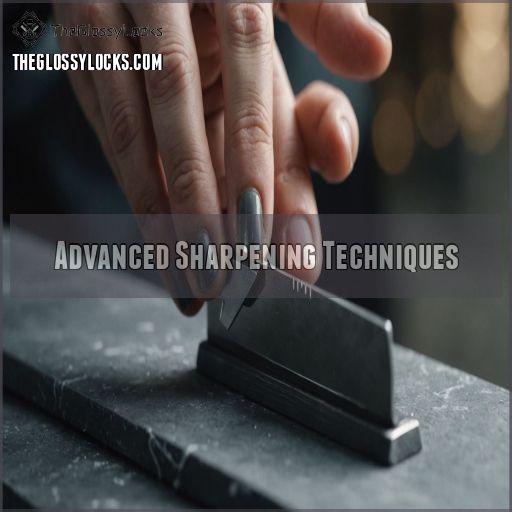This site is supported by our readers. We may earn a commission, at no cost to you, if you purchase through links.
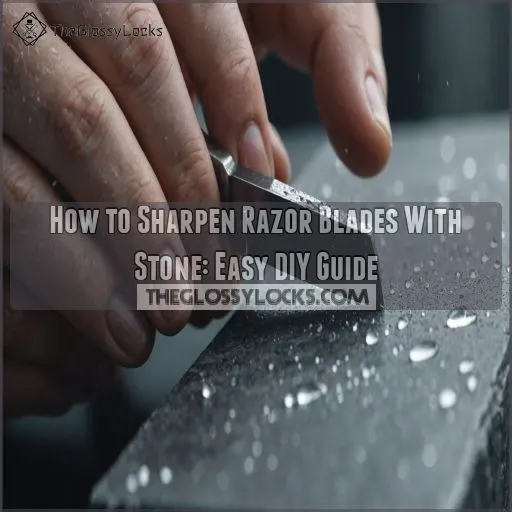 Alright, let’s get that straight razor of yours sharpened to perfection! First, choose the right sharpening stone – match the grit to your blade type. Then, clean that baby up by scrubbing away any grime or oxidation.
Alright, let’s get that straight razor of yours sharpened to perfection! First, choose the right sharpening stone – match the grit to your blade type. Then, clean that baby up by scrubbing away any grime or oxidation.
Time to get positioning – hold that blade at just the right 30-degree angle and glide it across the stone with light, even pressure. Repeat until you’ve got the edge you want.
Now for the finishing touches – hone that edge on a finer stone, then strop it on some leather to really make it sing. Voila, your straight razor is ready to deliver the smoothest, closest shave ever. But we’ve only scratched the surface – let’s dive deeper into mastering this art.
Table Of Contents
- Key Takeaways
- Choosing the Right Stone
- Preparing the Razor Blade
- Positioning the Razor Blade
- Sharpening the Razor Blade
- Honing the Razor Blade
- Stropping the Razor Blade
- Maintaining the Razor Blade
- Common Sharpening Mistakes
- Advanced Sharpening Techniques
- Frequently Asked Questions (FAQs)
- Can you sharpen a blade with a stone?
- How to sharpen a straight razor with a wet stone?
- How to make razor blade sharper?
- How do you sharpen clipper blades with a stone?
- How often should razor blades be sharpened?
- Can honing damage a razor blade?
- What materials are needed for sharpening?
- How to test razor blade sharpness?
- Are all razor blades suitable for sharpening?
- Conclusion
Key Takeaways
- Choose the right sharpening stone – match the grit to your blade type for a precision edge. It’s like finding your perfect pair of jeans – comfort matters.
- Prep your razor blade like a pro by scrubbing away grime and oxidation. Keeping it squeaky clean is the key to a smooth, nick-free shave.
- Master the art of positioning – hold that blade at the perfect 30-degree angle and glide it across the stone with a light, even touch. It’s all about finding that sweet spot, like balancing a wobbly table.
- Hone and strop that edge to perfection – use a finer stone to refine the blade, then give it a gentle polish on some leather. It’s like a spa day for your razor, leaving it sharper than a lawyer’s wit.
Choosing the Right Stone
When you’re sharpening your razor blades with a stone, choosing the right one can make all the difference between a smooth shave and a scratchy mess.
Don’t worry, picking the ideal stone is simpler than deciding between pineapple or pepperoni on your pizza, and we’ll guide you through every step with ease and a laugh or two.
Types of Sharpening Stones for Razor Blades
When sharpening razor blades, choosing the right stone for the job is essential. choosing the right stone.
You’ve got sharpening stones of all types:
grit levels,
various materials,
sizes, and
shapes—like a rock buffet for your razor!
Selecting the Best Stone for Your Razor Type
What type of razor do you use? Choosing the right sharpening stone is key – match the grit to your blade’s needs for a precision edge.
Factors to Consider When Buying a Sharpening Stone
Buying a sharpening stone is like finding your perfect pair of jeans—comfort matters! Consider:
- Stone Type & Material
- Grit Level
- Size & Portability
- Price & Budget
Popular Brands and Models of Sharpening Stones
After considering factors, let’s explore popular sharpening stone brands. Explore choices like Norton, Shapton, and DMT for quality stones. Remember, everyone wants the best stone for sharpening razor blades!
Preparing the Razor Blade
Before sharpening your razor blade, you’ll want to give it a little TLC to make sure it performs well.
Just like cleaning your glasses, washing away debris and oxidation keeps your view crystal clear—or in this case, your shave smooth and nick-free.
Cleaning the Razor Blade Before Sharpening
Before sharpening, give your razor a good rinse under hot water.
Scrub it with a toothbrush to dislodge any gunk or grime.
This will help the blade glide smoothly across the stone.
Removing Debris and Oxidation From the Blade
Ditching debris and chasing away oxidation? You got this! Get a clean blade with:
- Toothbrush scrub: Dislodge grime.
- Warm water rinse: Refresh the blade.
- Polishing paste: Smooth the surface.
- Mirror technique: Flash that brilliance.
Keep those razor cartridges in tip-top shape!
Drying the Razor Blade to Prevent Rust
You’ve removed the gunk, now let’s stop rust in its tracks! Drying’s a big deal; it’s your blade’s BFF. Use a lint-free cloth or hairdryer. Store dry to avoid rust, help keep your shaves smooth, and contribute to sustainable grooming.
| Drying Tool | Usage Tip |
|---|---|
| Lint-Free Cloth | Pat, don’t rub, for drying |
| Hairdryer | Low heat, high speed setting |
| Silica Gel Pack | Store with blades for moisture |
Positioning the Razor Blade
Positioning your razor blade correctly on the stone is important for achieving a sharp edge without damaging the blade or your fingers.
Remember, holding the blade at just the right angle is as vital as balancing a wobbly table with a stack of napkins—avoid awkwardness for the best results!
Holding the Razor Blade at the Correct Angle
Holding the razor at the right angle is key – tilt it just so, like an old friend you’re greeting. This sweet spot makes for a smooth, confident sharpening stroke.
Placing the Blade on the Sharpening Stone
Setting the blade on the stone isn’t rocket science. Think of aligning a puzzle piece with its perfect slot.
To achieve the precise fit:
- Align the blade angle.
- Steady your hand.
- Keep firm, but gentle, blade pressure.
Adjusting the Blade Position for Optimal Sharpening
Think of your blade like a ballerina, gracefully pirouetting for best positioning.
Hold it with a firm yet gentle hand grip, ensuring edge alignment.
Adjust the blade angle at about 30 degrees, applying just enough stone pressure to avoid slips.
Sharpening the Razor Blade
You’ve got your stone ready, so let’s work on getting that razor blade back in top shaving shape to prevent razor burn by rinsing blades after each stroke.
Moving the blade with gentle pressure and a bit of finesse, you’ll sharpen it to perfection—ensuring those morning shaves feel more like a smooth glide than a tug-of-war with your whiskers.
Moving the Razor Blade Across the Stone
Now, gently glide the razor across the stone, following its contours.
Maintain a consistent angle to evenly sharpen the blade’s edge.
Take your time – no need to rush this step.
Applying Light Pressure for Effective Sharpening
Imagine the blade’s a delicate flower! Applying light pressure benefits your sharpening. Here’s how:
- Prevent blade damage.
- Optimize stone pressure impact.
- Balance pressure vs. sharpness for mastery.
Repeating the Sharpening Process for Desired Sharpness
Achieving that razor-sharp edge isn’t a one-and-done deal. You’ll need to repeat sharpening with the right stone grit and angle. Pay attention to the blade’s feel for finesse.
Sharpening the Blade in Multiple Directions
Sharpening the blade in multiple directions helps create a symmetrical edge and a really sharp blade.
Consider these approaches:
- Vary sharpening angles
- Maintain blade alignment
- Balance honing direction
- Adjust strop angles
- Check progress frequently
Honing the Razor Blade
Sharpening your razor is only half the battle – honing it to perfection is the key to a truly smooth shave.
Honing a blade edge to surgical precision, using a honing stone, allows it to glide effortlessly across your skin for an unparalleled grooming experience.
The Difference Between Sharpening and Honing
Think of sharpening as removing material to craft a new edge angle, while honing gently refines the edge without massive material removal.
Sharpening creates a fresh blade, but honing perfects it, delivering a smoother, more precise resulting edge.
Using a Honing Stone to Refine the Blade Edge
Imagine this: your old trusty blade, longing for that razor-sharp edge. Grab a honing stone and gently stroke the blade at a consistent angle. Apply light pressure—no need to muscle it. Hone like a boss, refining the edge beautifully.
Techniques for Honing the Razor Blade
Wondering how to finesse your razor blade’s edge? Master honing for longevity and sharpness.
- Hold a steady angle and let the stone work its magic.
- Use gentle strokes—don’t overdo it!
- Feel the smooth transformation under your hands.
Stropping the Razor Blade
Stropping is the secret to keeping your razor blades sharp and ready for action.
By running the blade across a leather strop, you’ll be able to polish and realign the edge.
This ensures a smooth, comfortable shave every time.
What is Stropping and How Does It Work
Honing’s done! Now, let’s chat about stropping your razor blade. Stropping uses leather to polish and straighten the edge.
Different strop materials, like leather, give you options.
Pay attention to stropping angles and maintenance for sharper, longer-lasting blades!
Using a Leather Strop to Polish the Blade Edge
When you’ve wrapped up learning about stropping fundamentals, it’s time to use a leather strop.
It’s like a gentle hug for your blade, keeping it sharp and precise.
- Strop materials: Leather’s the way to go.
- Strop maintenance: Keep that strop clean and supple.
- Blade angle: Aim for a firm but gentle touch.
Techniques for Stropping the Razor Blade
Now that you’ve got your leather strop ready, let’s master the art of stropping.
Apply gentle pressure at an angle, moving the blade toward you.
Maintaining the Razor Blade
Properly maintaining your razor blades is key to getting the most out of them, including safe and responsible razor blade disposal
. Clean and store your blades carefully, and follow a regular maintenance routine to keep them performing at their best.
Cleaning and Storing the Razor Blade
A little attention to blade hygiene makes a world of difference!
Clean your razor with soapy water and a soft toothbrush, preventing rust.
For storage options, dry it completely, then tuck it safely away.
Your blade’s lifespan will thank you!
Regular Maintenance for Optimal Performance
You’ve nailed it on cleaning and storing. For regular maintenance that keeps your blades singing like a barber’s quartet, remember:
- Blade Cleaning: After every use.
- Lubrication: Apply occasionally.
- Storage: Dry and cool like ice cream.
- Rust Prevention: Essential always.
Tips for Extending the Life of Your Razor Blade
Our razor’s life extends with proper storage—think of it as tucking your blade into a cozy blanket to prevent rust.
Keep it dry, store in a dry spot, and rotate usage.
Here’s a table to illustrate simple yet effective blade care:
| Blade Storage | Tip | Description |
|---|---|---|
| Drying | Use towel | Keeps rust away |
| Spritz | Alcohol | Disinfects edges |
| Storage | Use box | Safe from damage |
Common Sharpening Mistakes
Sharpening your razor blades can be tricky, but avoiding common mistakes is key to keeping them in top shape.
From over-sharpening to damaging the blade or stone, this section will walk you through troubleshooting any issues so you can get the perfect edge every time.
Avoiding Over-Sharpening the Razor Blade
Blades wear out faster if over-sharpened. To keep your razor sharp as a tack without going overboard, follow these tips:
- Watch the blade angle.
- Balance honing vs. sharpening.
- Control pressure.
- Check stone grit.
Preventing Damage to the Blade or Stone
As you sharpen, don’t let your enthusiasm chip the stone or dull the blade.
Keep a steady hand, a consistent blade angle, and gentle stone pressure.
Troubleshooting Common Sharpening Issues
If you’ve recently tackled stone selection and are experiencing sharpening headaches, don’t fret. Here’s a quick fix for those pesky issues.
- Check for blade damage.
- Address uneven sharpening.
- Correct honing mistakes.
- Resolve strop issues.
Happy sharpening!
Advanced Sharpening Techniques
Once you’ve mastered the basics, it’s time to take your sharpening skills to the next level.
Experiment with using multiple stones, customizing your sharpening angle, and advanced stropping and honing techniques to achieve a truly exceptional razor edge.
Using Multiple Stones for Custom Sharpening
Many folks swear by using multiple stones to get that razor blade sharp as a tack.
The key? Switching stones like a pro enhances control and optimizes sharpness.
Stone combinations and honing sequences for specific blade types can seem overwhelming, but here’s a quick guide:
| Stone Type | Purpose |
|---|---|
| Coarse | Initial shaping |
| Medium | Refining |
| Fine | Polishing |
| Extra-fine | Final detailing |
| Ceramic | Ultimate finish |
Creating a Custom Sharpening Angle
So, you’re aiming for that perfect angle.
It’s a bit like finding the sweet spot on a teeter-totter.
Experiment with the angle to retain your blade’s edge, ensuring it stays sharp without overdoing the sharpening technique.
Advanced Stropping and Honing Techniques
Now that you’ve got your sharpening angle down, let’s add finesse with these advanced tips:
- Choose the right leather strop types.
- Experiment with stropping angles.
- Select honing stone types.
- Master honing pressure and blade edge control.
Keep honing those skills!
Frequently Asked Questions (FAQs)
Can you sharpen a blade with a stone?
You can sharpen your blade with a stone by wetting it, placing the blade flat, and sliding it diagonally.
It’s like giving your blade a spa day, renewing its edge and extending its life.
How to sharpen a straight razor with a wet stone?
Sharpening your straight razor with a wet stone is like pampering your blades at a spa, using honing stones of varying grits. Wet the stone, place the razor flat, and gently slide diagonally, leading with the edge. Consistency keeps your shave silky smooth.
How to make razor blade sharper?
Tired of dull blades? Toothpaste‘s the ticket!
Just rub it on, let it heat up, and voila – your razor’s sharper than ever.
Trust me, this quick fix’ll have you slicing through stubble like a hot knife through butter.
How do you sharpen clipper blades with a stone?
Give those clipper blades some love with a honing stone.
Wet the stone, lay the blade flat, and slide diagonally.
Repeat a few times on each side, and voila, sharper blades that’ll cut like a hot knife through butter!
How often should razor blades be sharpened?
Razor blades can dull faster than a cheetah on a treadmill!
Sharpen them every 2 to 4 weeks, depending on use.
Pay attention to your razor’s performance.
It’ll tell you when it’s craving a good honing.
Can honing damage a razor blade?
Honing can be risky if you’re heavy-handed or rushing it.
Go slow and steady like the tortoise in the race; it’ll make sure you don’t chip or damage the edge, keeping your razor sharp and smooth.
What materials are needed for sharpening?
You’ll need just a few simple items – a honing stone, some water, and a steady hand.
With a little practice, you’ll be sharpening those blades like a pro in no time!
Did you know that proper honing can actually double the lifespan of your razor?
How to test razor blade sharpness?
Testing sharpness can be a bit like slicing through butter.
Gently run it across a hair or thin paper; if it glides effortlessly without snagging, it’s sharp.
If not, it needs a touch-up.
Are all razor blades suitable for sharpening?
In the delicate dance of blade and stone, not all blades are suited for sharpening.
Electric blades, like a singer without a song, won’t sing.
But, your traditional razors and double-edge blades can benefit greatly.
Conclusion
Consider sharpening those razor blades like taming a wild beast; it’s challenging, but once conquered, it’s exhilarating.
Now, you’re a seasoned pro at how to sharpen razor blades with stone.
Armed with the right stone, angle, and technique, you can turn a dull blade into a sleek performer.
Your straight razor, sharper than a lawyer’s wit, awaits to provide a smooth shave, minus the nicks.
So, get sharpening, and may your shaves be ever gentle and fun!

